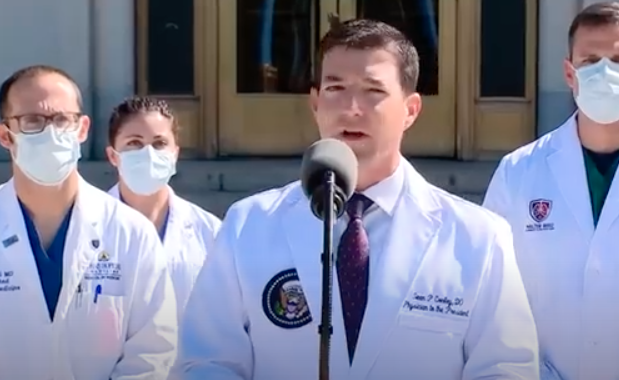Lessons From the White House Doc’s Pressers

In the wake of President Donald Trump’s COVID-19 diagnosis, White House physician Sean Conley’s performance at press conferences over the weekend was itself determined to be sickly. Some of the criticisms were on-target, providing lessons for crisis communicators.
The pressers were held outdoors at the Walter Reed Medical Center in Bethesda, Maryland, where the president was brought Friday, Oct. 2. The most contentious issue arose at the journo gathering the next day. Conley (pictured) was asked whether the president had been given supplemental oxygen. He replied, “He’s not on oxygen right now. That’s right.”
But the question was whether the president had been given oxygen since his COVID-19 diagnosis. It was repeated several times and several times Conley replied that the president wasn’t on oxygen “right now.” He eventually said the president wasn’t given oxygen on either Thursday, Friday or Saturday. Still, he came off as evasive.
Then, at the press conference the next day (Sunday, Oct. 3), the doctor admitted that Trump had been given oxygen for about an hour on Friday morning before being taken to the hospital.
Asked why he had been reluctant to admit this earlier, Conley said he was trying to be “upbeat.” “I didn’t want to give any information that might steer the course of illness in another direction and in doing so, it came off that we were trying to hide something, which wasn’t necessarily true,” he said.
Reporters picked up on this comment because it didn’t seem to make sense that disclosing information could affect the course of a disease.
President’s Vitals
The other big issue was related to the rosy picture presented of Trump’s condition. Right after the Saturday briefing, White House Chief of Staff Mark Meadows was much more dour. “The president’s vitals over the last 24 hours were very concerning, and the next 48 hours will be critical in terms of his care,” he told reporters. “We’re still not on a clear path to a full recovery.”
At the Sunday presser, a reporter provocatively asked Conley about the conflicting prognoses: “Simple question for the American people: Whose statements about the president’s health should we believe?” Conley said Meadows’ statement was “misconstrued” — he was speaking about a particular moment when Trump’s condition was concerning. It wasn’t convincing.
The damage was done. The president’s medical team came off as evasive (on other issues, too, such as his last negative test and his lung condition), and the contradictory messages from it and the chief of staff were troubling. On the oxygen issue, the doctor had been cagey and then admitted he hadn’t told the truth.
Granted, this happened in a particular, politically charged milieu — one that also involved someone’s protected health information. Still, for crisis communicators it’s a reminder of the importance of disclosing facts, getting those facts right the first time and coordinating messaging among team members. It shows the importance of taking crisis communications seriously.
— Thom Weidlich
Photo Credit: C-Span via YouTube
This is an abridged version of an article that appeared today on the CrisisResponsePro paid subscription portal. (CrisisResponsePro subscribers can access the full version by clicking here. ID and password are required.) To take advantage of all of the content, data, and collaborative resources CrisisResponsePro has to offer, contact us at info@crisisresponsepro.com.




 Back to Blog
Back to Blog